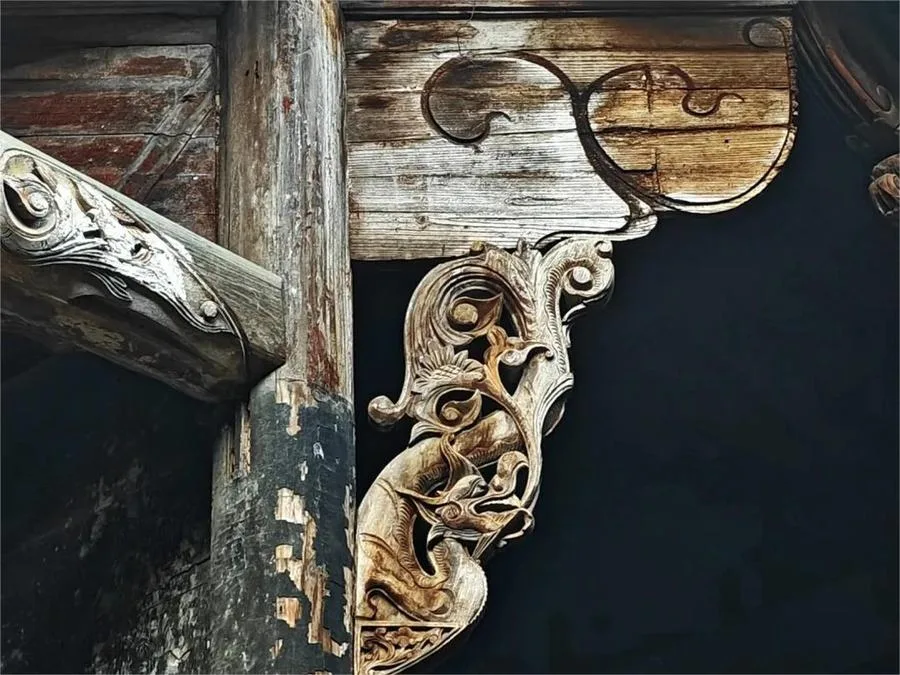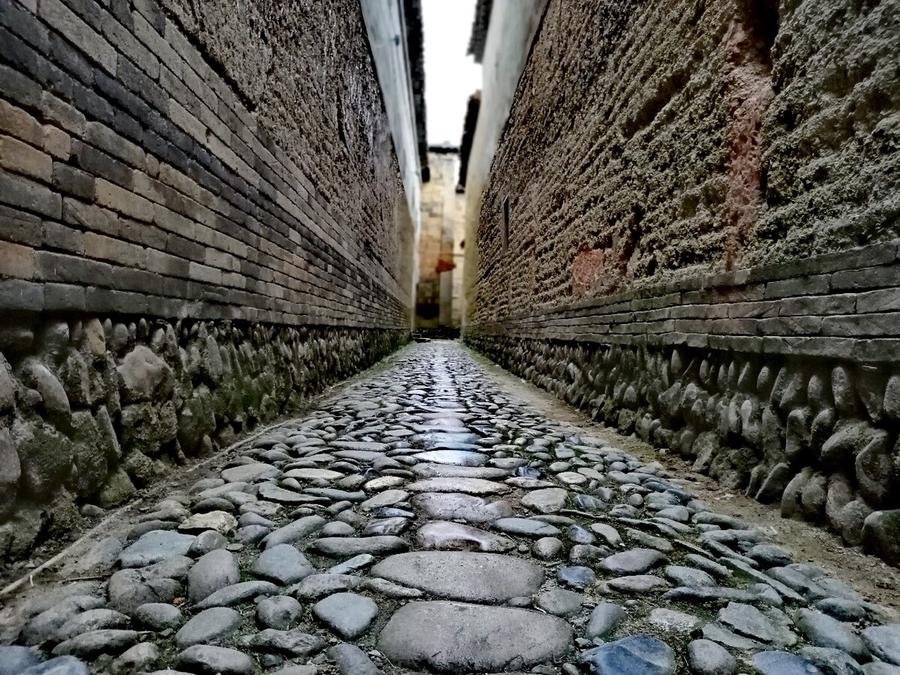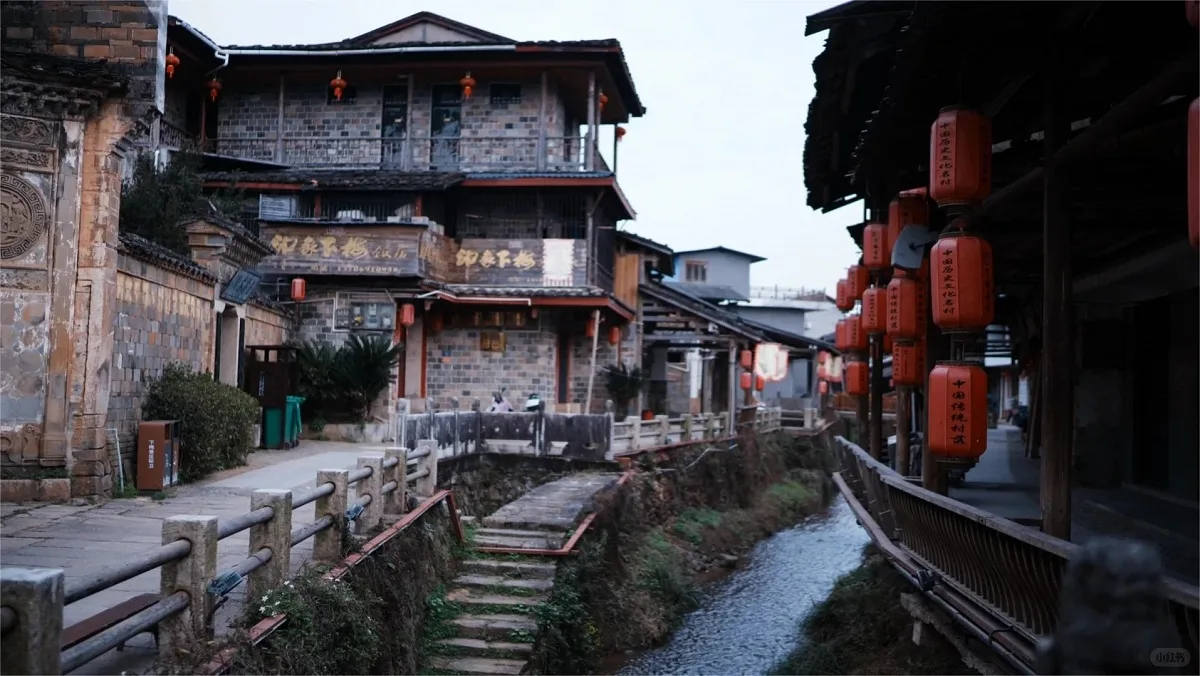Xiamei Ancient Residence (下梅古民居群) is an integral part of the Wuyi Mountain World Cultural Heritage Site in Fujian Province, China. With a rich history and a confluence of cultural influences, Xiamei is a picturesque village characterized by Ming and Qing dynasty architectural styles. The ancient residences feature a harmonious blend of brick, stone, and wood carvings, presenting a rustic and authentic appearance. The village’s unique architectural ensemble is further accentuated by a 900-meter-long man-made canal that runs through it, flanked by elegant pavilions and stone railings.
Xiamei’s prosperity peaked in the early Qing Dynasty when it became a significant tea distribution center for the Wuyi Mountains. The village’s central canal, known as Dangxi, bustled with activity at its eight busy docks. The flourishing tea trade brought wealth to the region. The four Zou brothers of Xiamei amassed great wealth and built over 70 grand mansions, marking their prominence in the village. Following their lead, other affluent families, including the Fang, Cheng, Yue, and Chen families, constructed their residences in Xiamei, resulting in a distinctive and sizable architectural cluster.
These buildings are arranged along the canal, with structures ranging from the opulent homes of merchants and officials to the study halls and leisure facilities of scholars. The layout and functionality of these buildings reflect the diverse needs of the inhabitants, emphasizing residential use while also accommodating education, gatherings, leisure, and entertainment.
Table of Contents
- Basic Information
- Location and Transportation
- Highlights of Xiamen Ancient Residence
- Other Attractions in Wuyi Mountain
Basic Information
| Estimated Length of Tour | 1 – 2 hours |
| Ticket Price | 50 RMB |
| Opening Hours | 7.30 – 17.30 |
| Telephone Number | 0086-0599-5206999 |
Location and Transportation
Xiamei Ancient Residence is located about 12 kilometers southeast of Wuyishan City and only 8 kilometers from the Wuyishan Scenic Area. To get there, you can take a bus from the south entrance of the Wuyishan Scenic Area. The route passes through several stops including the Tea Expo Garden, Sangu Ring Island, Ziyang Ancient City, and Chishi Memorial Hall, before reaching Xiamei. The first bus departs at 7:00 AM, and the last bus departs at 5:00 PM.
Highlights of Xiamen Ancient Residence
Artistic Carvings

One of the most striking features of Xiamei Ancient Residence is its exquisite carvings in brick, stone, and wood, as well as the colorful wall paintings. These elements combine to create an artistic masterpiece that reflects the luxurious and prosperous life of its historical inhabitants.
Brick Carvings: Every entrance gate of the residences is adorned with intricate brick carvings, showcasing both relief and openwork techniques. The subjects of these carvings often draw from historical figures, mythical tales, and auspicious symbols from folklore. The detailed craftsmanship captures lifelike characters and natural environments, imbuing each carving with deep cultural significance and vibrant spirit.

Stone Carvings: Stone carvings are prominently used in functional and decorative elements such as foundation stones, door bases, stone drums, flower stands, pool railings, well heads, and water tanks. These carvings serve dual purposes as both practical objects and ornamental pieces, representing the pinnacle of craftsmanship that marries utility with aesthetic appeal.
Wood Carvings: The wood carvings in Xiamei Ancient Residence are equally spectacular, found in beams, ceilings, furniture, railings, window lattices, and pillar bases. Among these, the window lattices stand out the most. These windows, often composed of four, six, or eight panels, feature intricate openwork patterns that maximize their artistic impact. Common motifs include popular animals, plants, human figures, and auspicious clouds, reflecting the traditional virtues of diligence, kindness, loyalty, and filial piety cherished by the local people.
Zou Clan Ancestral Hall

A significant cultural landmark within Xiamei Ancient Residence is the Zou Clan Ancestral Hall, situated on the northern bank of Dangxi Stream. Built in the 55th year of the Qianlong reign (1790) during the Qing Dynasty, this hall occupies over 200 square meters and is constructed from brick and wood. It was funded by the Zou brothers, Maozhang and Yingzhang, to honor their ancestors.
Architecture and Design: The entrance of the hall features a mantelpiece-style design with symmetrical brick carvings. To emphasize the importance of familial and ancestral ties, the entrance is adorned with two engraved calligraphy pieces, “Wood Roots” and “Water Source,” symbolizing the interconnectedness of lineage and heritage. In front of the entrance, horse stones and stone drums serve as markers for descendants arriving to pay respects.
Interior and Decorations: Inside, the hall houses stele inscriptions detailing the clan’s history and ancestral rules. The main hall is open, flanked by side rooms, with an upstairs area serving as a stage for performances. The front corridor is supported by intricately carved wooden columns, capable of holding lanterns and floral decorations. A four-paneled wooden screen door, featuring carvings that depict ethical principles, ancestral traditions, and daily life, serves as the focal point. The distinctive double-wave firewalls add grandeur and majesty to the structure.
Zou’s Grand Mansion

Located on North Street in Xiamei Village, Zou’s Grand Mansion is a Qing Dynasty building named after its owner, who was awarded the honorary title “中宪大夫 (Zhongxian Dafu)”. The mansion’s entrance is paved with blue stone, flanked by well-preserved hitching posts and flagpole bases. The entire façade of the main gate is adorned with elaborate brick carvings, depicting a variety of themes in lifelike detail. These carvings use a combination of relief and openwork techniques, creating a multi-layered and well-composed visual effect.
The side windows are embellished with wood carvings, featuring bats, flowers, and geometric patterns, adding a touch of opulence to the building. Inside the mansion, decorative wooden brackets, once gilded with gold characters and couplets, enhance the elegance of the interior. Each courtyard has two stone flower stands, one tall and one short, which add to the aesthetic appeal.
Behind the house lies a garden called “小樊川 (Xiaofanchuan),” designed in the style of a southern Chinese garden. The garden features a “Mirror Moon” terrace, a goldfish pond, a chess-playing platform, and stone flower stands. The garden is planted with luohan pines, and the embedded windows are decorated with double-sided floral brick carvings, creating a picturesque scene that evokes a sense of serene beauty. The spacious and bright architecture of Zou’s Grand Mansion reflects the wealth and prominence of its owner. It is one of the best-preserved ancient residences in Xiamei Village and was listed as a protected cultural relic in Fujian Province in 2000.
Dali Alley

Dali Alley is located at the entrance of Fang’s Residence on North Street in Xiamei Village, adjacent to Fang’s “Sanjun Mansion.” The alley was constructed around 1755 during the 20th year of Emperor Qianlong’s reign. At that time, descendants of Zou Maozhang, the wealthiest man in Xiamei, built their home south of Fang’s Sanjun Mansion. The back walls of both houses were close together, preventing the construction of a back door for either residence.
The Fang family, who served as military officers and had lost soldiers in battle, were honored for their loyalty and valor. However, they were financially impoverished. The Zou family, recognizing the Fang family’s contributions, frequently provided financial assistance. Grateful for their support, the Fang family agreed to give up part of their wall, allowing the Zou family to build a back door. The Zou family then constructed a 30-meter-long alley next to the Fang family’s eastern fire wall, spending several hundred taels of silver in the process. This alley was later named “Dali Alley,” meaning “Reasonable Alley,” symbolizing the mutual understanding and respect between the two families.






